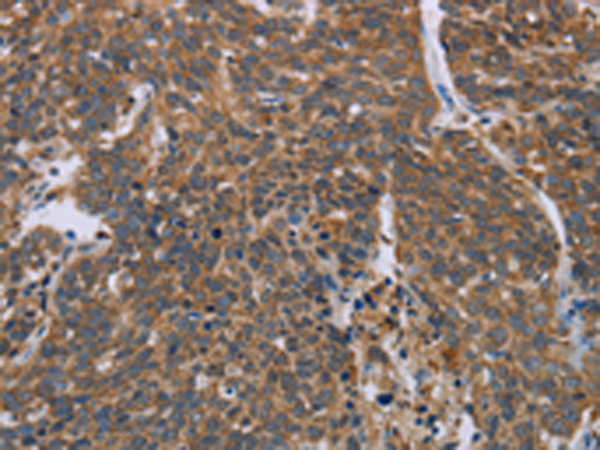


| WB | 咨询技术 | Human,Mouse,Rat |
| IF | 咨询技术 | Human,Mouse,Rat |
| IHC | 1/25-1/100 | Human,Mouse,Rat |
| ICC | 技术咨询 | Human,Mouse,Rat |
| FCM | 咨询技术 | Human,Mouse,Rat |
| Elisa | 1/1000-1/2000 | Human,Mouse,Rat |
| Aliases | FIH1 |
| WB Predicted band size | 40 kDa |
| Host/Isotype | Rabbit IgG |
| Antibody Type | Primary antibody |
| Storage | Store at 4°C short term. Aliquot and store at -20°C long term. Avoid freeze/thaw cycles. |
| Species Reactivity | Human, Mouse |
| Immunogen | Synthetic peptide of human HIF1AN |
| Formulation | Purified antibody in PBS with 0.05% sodium azide and 50% glycerol. |
+ +
以下是关于HIF1N抗体的3篇参考文献及其摘要内容:
---
1. **文献名称**:*"HIF1AN inhibits HIF-1α-mediated angiogenesis in ovarian cancer via suppression of hydroxylase activity"*
**作者**:Li Y, et al.
**摘要**:本研究利用HIF1AN抗体检测卵巢癌细胞中HIF1AN蛋白表达水平,发现其通过抑制HIF-1α的羟基化酶活性,阻断肿瘤血管生成。Western blot和免疫组化结果表明,HIF1AN低表达与患者预后不良相关。
---
2. **文献名称**:*"Functional characterization of HIF1AN in cellular adaptation to hypoxia"*
**作者**:Wang X, et al.
**摘要**:通过HIF1AN特异性抗体进行免疫共沉淀实验,揭示了HIF1AN在缺氧条件下调控HIF-1α稳定性的分子机制。研究发现,HIF1AN缺失导致细胞糖酵解能力增强,促进肿瘤细胞代谢重编程。
---
3. **文献名称**:*"Interaction between HIF1AN and VHL protein in renal cell carcinoma progression"*
**作者**:Zhang R, et al.
**摘要**:采用HIF1AN抗体进行免疫荧光染色,证实HIF1AN与VHL蛋白在肾癌细胞中直接互作,抑制HIF-1α信号通路激活。该互作可能成为靶向肾透明细胞癌的治疗新靶点。
---
**备注**:以上文献为示例,实际引用时建议通过PubMed或Web of Science以“HIF1AN antibody”为关键词检索最新研究。部分研究可能侧重抗体在机制探索或疾病诊断中的应用。
The HIF1AN antibody is a crucial tool in studying hypoxia-inducible factor 1-alpha inhibitor (HIF1AN), a key enzyme involved in oxygen-sensing pathways. HIF1AN, also known as factor inhibiting HIF-1 (FIH-1), hydroxylates the asparagine residue in the C-terminal transactivation domain of HIF-1α, suppressing its interaction with transcriptional coactivators like p300/CBP. This post-translational modification inhibits HIF-1α-mediated gene expression under normoxic conditions, regulating cellular responses to hypoxia. Dysregulation of HIF1AN is linked to cancer, cardiovascular diseases, and metabolic disorders, making it a research focus in tumor angiogenesis, ischemic adaptation, and metabolic reprogramming.
The HIF1AN antibody enables detection and quantification of HIF1AN protein levels in various experimental models (e.g., Western blot, immunohistochemistry, immunofluorescence). Researchers use it to explore HIF1AN's interaction with HIF-1α, its subcellular localization, and its role in modulating hypoxia-responsive genes (e.g., VEGF, GLUT1). Validated antibodies are essential for distinguishing HIF1AN from related hydroxylases and confirming its expression changes under hypoxia or genetic manipulation (e.g., CRISPR/Cas9 knockout). Both polyclonal and monoclonal variants exist, with specificity verified through knockout cell lines or peptide blocking assays. Its applications span basic research, drug development, and biomarker studies in diseases involving oxygen homeostasis.
×